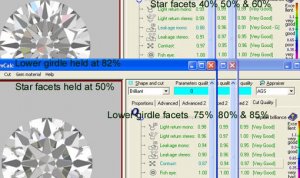- Joined
- Aug 15, 2000
- Messages
- 19,118
Jonathon just mentioned this issue in another thread, and I just wanted to jump down his and all the others who spread or exaggerate this idea.
This includes the GIA who never said much in their article about the subject(because that gets seriously edited and what they say there must be acceptable as fact to the G&G editors). All the missinformation has been spread in a hearsay way.
Anyway enough soap boxing

Here are the Diamcalc2 results for the standard default stone with adjustments to upper and to lower facets seperately.

This includes the GIA who never said much in their article about the subject(because that gets seriously edited and what they say there must be acceptable as fact to the G&G editors). All the missinformation has been spread in a hearsay way.
Anyway enough soap boxing

Here are the Diamcalc2 results for the standard default stone with adjustments to upper and to lower facets seperately.













300x240.png)